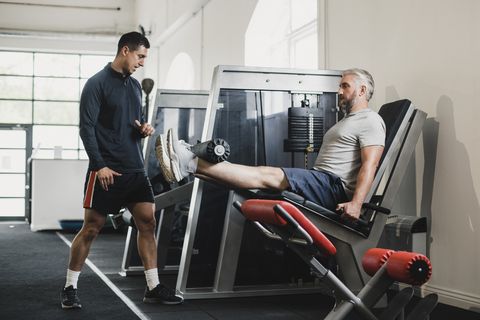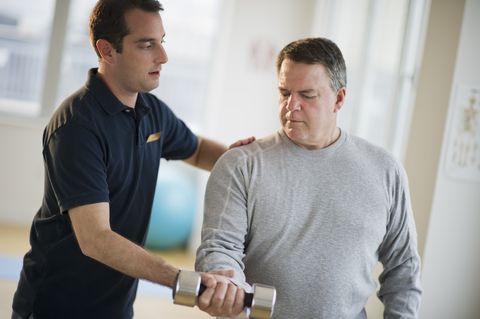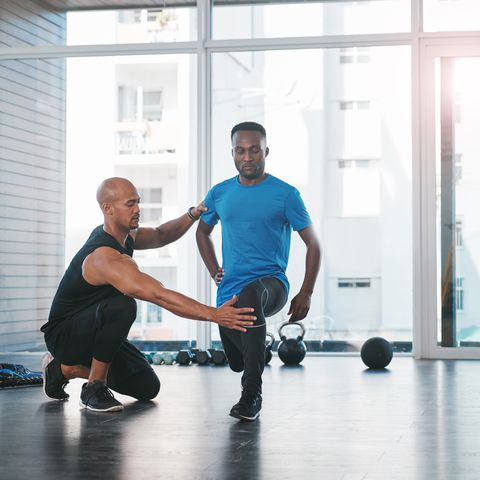How I Learned That Not All Trainer Certs Are Legit
It was a hell of a journey to my new career and life, but at 10:00 p.m. on a recent Tuesday, I was on the cusp of fulfilling my dream of becoming a certified fitness instructor. The last step: a 40-question, 40-minute, multiple-choice test on my computer. “How many calories does one gram of protein provide?” Doozy. “To which group of muscles do the pectorals belong?” The…chest? Probably a trick question.
To think that it had been just a few days since I first considered getting certified. Why not, right? Seemed like a good gig. Decent pay. Flexible hours. I’m a people person! So I signed up for a $20 Groupon offer at a site called ExpertRating.com, which has a course in personal training and promises “a premium international certification that is recognized by hundreds of employers and government bodies.”
After some light studying, I took the test in my kitchen, googling as I went. (A gram of protein has four calories, by the way. And the pecs are chest muscles, which only experts, and Google, know.) I ended up answering 30 of the 40 questions right, and apparently this was enough to qualify me as an expert.
I am now Jeff Tomko, personal trainer, and after the test, I got an email with a downloadable certificate that proved it. Three weeks later, I received the real-deal certificate in the mail, and I’m ready to guide you toward your fitness goals, taking your money and putting your health at risk, despite never having worked with a client or, you know, studied fitness.
Assuming, of course, a gym will let me partner up with them—which, it turns out, might not be a problem.
The Dawn of Brawn

CasarsaGuruGetty Images
There are now anywhere from 400,000 to 500,000 full- and part-time fitness trainers in America, according to the nonprofit Coalition for the Registration of Exercise Professionals. And the Bureau of Labor Statistics projects full-time training jobs will swell by 10 percent by 2026, fueled by the spread of corporate employee-health programs, the rise of social-media fitness influencers, and the growth of CrossFit.
Personal training is booming, part of a $30 billion fitness industry in the United States, so my certification turned out to be a helluva career move. There are lots of ways to get “certified.” You can attend a two-day clinic and take a test for your CrossFit Level 1 certification. You can become an American Sports & Fitness Association water-aerobics instructor with a lifetime renewal, taking the test instantly (and as many times as you want) and paying the $499 fee only if you pass. Or you can do CorePower Yoga teacher training, which a spokesperson said is less about prepping you to teach (despite, you know, its name) and more about helping you “take your practice to the next level.”
Forty-five years ago, none of those certs existed. The modern fitness-training industry emerged in the 1950s with bodybuilder and exercise-machine designer Jack LaLanne, who had a popular television show. But strength training was a male-dominated, niche activity, so few could make a living with personal training. “You had your bodybuilding gyms, and that was considered odd,” says trainer and fitness historian Mike Boyle, C.F.S.C., A.T.C. That began to shift in 1976, when Arnold Schwarzenegger flexed his muscles in Stay Hungry.
Then Richard Simmons and Jane Fonda kicked off the aerobics boom of the 1980s, and personal training evolved as a viable and legitimate profession. “In the ’80s, I would say having a personal trainer was probably a symbol of affluence,” says Boyle. “You know, much like having a car phone.” The American College of Sports Medicine (ACSM) started issuing certifications in 1975. Then, in 1985, the American Council on Exercise (ACE), a nonprofit working to make fitness more accessible, began certifying trainers for group exercise.
By 1987, the National Commission for Certifying Agencies (NCCA) oversaw all fitness-certification processes. Currently it recognizes 16 organizations, including the ACSM and the National Strength and Conditioning Association (NSCA). At a minimum, all top certs require a high school diploma or equivalent—and several hundred dollars up front. The NSCA’s certified strength and conditioning specialist test, a rigorous cert that requires months of study and a bachelor’s degree, is the gold standard for fitness certifications.
Understanding Certs

Tim RobbertsGetty Images
The problem is that most people looking for a trainer can’t differentiate between a good certification and a bad one, says Jonathan Goodman, a former C.S.C.S. trainer and the author of Ignite the Fire: The Secrets to Building a Successful Personal Training Career. “An alphabet soup after anyone’s name looks like credibility,” says Goodman, who once signed up his dog Bucky for a training cert.
According to the ACE, there are more than 100 providers offering nonaccredited certifications, doling out credentials like the one I received from ExpertRating and the $89 online cycling-training cert I got from the National Personal Training Association. Many claim their certs are legit. ExpertRating initially said in an email that “with the exception of the LA Fitness chain of fitness centers, all accept our certification.” But after several major fitness chains told Men’s Health they didn’t accept ExpertRating-certified trainers, the company reversed its stance. “We do not have an official affiliation with any fitness center or chain of fitness centers to accept our certifications,” said an ExpertRating rep.
This confusion speaks to a messy truth: All gyms have different requirements for their trainers. Gold’s Gym and Planet Fitness told MH they hire trainers only with NCCA-accredited certificates. Many Equinox gyms require the same and often demand more, says personal-training manager David Otey, C.S.C.S. Otey wants his trainers to have a “desire to keep seeking new fitness information.”
Anytime Fitness, which has more than 4,000 locations internationally, was fine with ExpertRating. “If you were a cultural fit, I might hire you with the expectation that you would get a higher-level cert or degree in a set period of time,” I was told in an email. Crunch, meanwhile, puts trainers through a process that includes an in-person interview, a phone interview, and a floor test—but there’s a loophole. “We will hire someone without their certification,” says Jenn Burke, NASM, Crunch’s director of education. “But they will be required to pass an NCCA-accredited certification within 60 days of hire.”
Burke’s point is important: Certifications aren’t everything. Easy certs can be a harmless way to start working with clients while improving your fitness education. Furthermore, some quality trainers don’t have any certs, but they were athletes or bodybuilders themselves and forged experience working with clients.
Training Gone Bad

SolStockGetty Images
For every legit expert, however, there’s one defined only by letters. And the “expert everything” era we live in has led to an explosion of niche certifications for everything from maces to kettlebells to nebulous terms like “foundations.” Such credentials aren’t bad, because any opportunity to deepen your training knowledge is always positive. But these nich certs don’t necessarily equip a trainer to teach you those skills, says Don Saladino, NASM, who runs the Drive 495 gym in New York City: “Gimme a break. They fill all these certs with fluff.”
The fluff leads to injuries. The Consumer Product Safety Commission estimates that about half a million people hurt themselves using exercise equipment yearly, and there’s been an uptick in lawsuits against trainers, according to fitness-business journal Club Industry. In 2016, a $10.9 million verdict went to a 42-year-old Connecticut man. He complained of blurred vision and begged to stop mid-session, but the trainer pushed him to go harder on the rower, resulting in a stroke.

Tetra ImagesGetty Images
The year before, a $980,000 verdict went to a 45-year-old New York woman who suffered a back injury after her trainer had her do jumping jacks, burpees, and deadlifts even though she’d said she recently had spinal surgery. And in 2014, a 62-year-old Connecticut woman who slipped off a Bosu and fractured her hip and wrist won a $750,000 verdict.
Ill-trained trainers often push clients too hard. ACSM’s Health & Fitness Journal identified three common issues in negligence lawsuits against trainers: unnecessary high-intensity training, training outside the scope of practice, and improper instruction and supervision. Unqualified trainers can’t always spot bad form or teach good form, making injuries more likely, says Jordan Metzl, M.D., a sports physician at the Hospital for Special Surgery in New York and author of Dr. Jordan Metzl’s Workout Prescription.
Unqualified trainers also can’t design efficient programs, limiting gains and motivation. This is what happens when an industry lacks regulation, says Walter Thompson, immediate past president of the ACSM. Some steps have been taken to solve this: The Coalition for the Registration of Exercise Professionals, which is made up of NCCA-accredited organizations, keeps a public database of all the nation’s NCCA-accredited certified trainers at usreps.org.
Thompson would like more stringent requirements: “Preferably a minimum of a bachelor’s degree in exercise science and a certification should be required for trainers to get hired.” None of this makes it easy to separate good trainers from dangerous ones right now. Here are five red flags to watch out for when you’re looking for a new trainer.
Trainer Fraud Alert!

Westend61Getty Images
No Goals
Your first session should start with a conversation. Here the trainer can learn about your medical history and goals, which should drive your workouts.
No Mercy
Too many trainers take pride in building workouts you can’t survive, says Saladino. If your trainer tells you to “go harder” more than four times in your first session, go hard—for the exit.
No Simplicity
Beware anyone who tries to impress with exotic moves, says Saladino. If you’re having trouble doing a standard lunge, your trainer shouldn’t have you doing a lunge and shoulder press. If you feel uncomfortable doing any exercise, speak up. If your trainer insists you push through twice and doesn’t explain why, walk away.
No Limits
Some moves shouldn’t be in your first workout—not because they’re “bad” but because a trainer won’t know if you’re ready for them, says MH fitness director Ebenezer Samuel, C.S.C.S. If these moves show up in the middle of your first workout, ask why you’re doing them.
Max-Height Box Jump: Completing a max-height box jump requires stability that your trainer can’t assume you have.
Barbell Power Clean and Snatch: Explosive barbell lifts place a burden on your shoulders and can lead to injury if they’re done too early in a fitness journey.
Burpee: If this is the last move in your first workout, that’s fine. It shouldn’t be the first; a burpee requires coordination and mobility that you may or may not have.
No Feedback
You’re working with a trainer because they’re a hands-on coach, says Otey. That means more than just counting reps; it means coaching you to better movement. At least twice in your first workout, ask your trainer to assess your form. No feedback? You’re trainer’s not offering much for the long term. So maybe—just maybe—the education they have doesn’t meet what you need.
The Certs That Matter

PeopleImagesGetty Images
Not all certifications are created equal—not even the good, accredited ones. The information below can help you find the right trainer for your goals.
C.S.C.S.
This one needs a college degree, and the test requires 5 to 7 months of study time. Look for a trainer with this cert if you’re a performance athlete, or you’re training for a sport.
NSCA-CPT
This cert has no college-degree prerequisite and usually requires 3 to 5 months of study. Look for a trainer with this cert if you need a well-rounded strength program.
NASM
Would-be trainers will spend 1 to 3 months studying and master the basics of corrective exercise. Trainers like this are terrific if you’re struggling with a muscle imbalance or bouncing back from an injury.
ACSM
Trainers prep to work with physical therapists. They’ll study for 3 to 5 months. These trainers are good if you’re just starting out in your journey to get fit.
ACE
Prospective trainers spend 1 to 3 months studying and obtain a solid grasp of muscle science. Look for these trainers if you’re aiming for a good group workout with some friends.
CrossFit Level 1
CrossFit’s starter cert preps trainers strictly for boxes with two days of instruction. These trainers are best equipped to put you through specific CrossFit WODs.
Expert Rating
Most gyms say they wouldn’t accept this certification. Best study method? Lots of Google. Consider this if, you know, you’re not too worried about your trainers’ certification.
Source: Read Full Article


